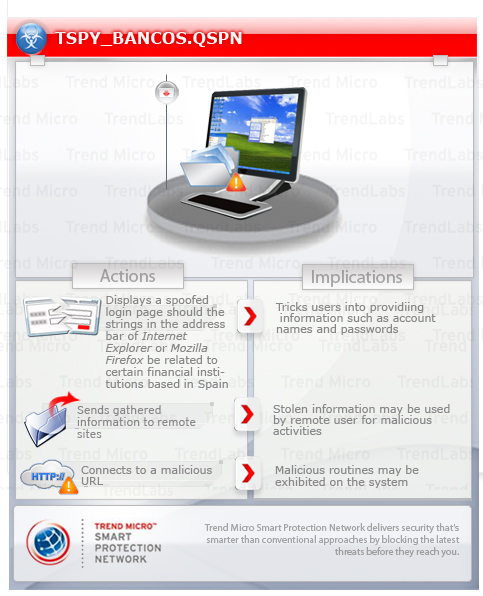TSPY_BANCOS.QSPN
Windows 2000, Windows XP, Windows Server 2003


Threat Type: Spyware
Destructiveness: No
Encrypted: Yes
In the wild: Yes
OVERVIEW
This spyware monitors Internet Explorer and Mozilla Firefox if the strings in the address bar or title bar are related to certain financial institutions based in Spain.
To get a one-glance comprehensive view of the behavior of this Spyware, refer to the Threat Diagram shown below.

Upon execution, this spyware connects to a site which contains links to where the spyware can report its installation. As of this writing, the site points to possibly compromised URLs. The HTTP request for the installation report it sends contains certain data.
This spyware may be downloaded by other malware/grayware from remote sites.
TECHNICAL DETAILS
2,191,360 bytes
EXE
Yes
19 Jul 2011
Connects to URLs/IPs
Arrival Details
This spyware may be downloaded by the following malware/grayware from remote sites:
- TROJ_BANLOD.QSPN
It may be downloaded from the following remote sites:
- http://www.{BLOCKED}rett.no/////mazda.exe
- http://www.{BLOCKED}rett.no/mazda.exe
Autostart Technique
This spyware adds the following registry entries to enable its automatic execution at every system startup:
HKEY_LOCAL_MACHINE\SOFTWARE\Microsoft\
Windows\CurrentVersion\Run
SIMP = "{malware path and file name}"
Information Theft
This spyware monitors the Internet Explorer (IE) activities of the affected system, specifically the address bar. It recreates a legitimate website with a spoofed login page if a user visits banking sites with the following strings in the address bar and/or title bar:
- Banco Popular
- Bankinter
- Caixa
- Cajasol
- Wester Union
Stolen Information
This spyware saves the stolen information in the following file:
- C:\updspapi.dll
Drop Points
This spyware sends the information it gathers to the following email addresses:
- {BLOCKED}berto2015@gmail.com
NOTES:
Apart from monitoring the Internet Explorer activities, it also monitors the Mozilla Firefox. The abovementioned financial institutions are all based in Spain.
Upon execution, this spyware connects to the following site:
- http://{BLOCKED}s:81/images/cancel.txt
- http://www.{BLOCKED}k.im/images/stories/dudley.php
- http://{BLOCKED}be/cms/images/smilies/envio.php
- http://{BLOCKED}ividad2011.es/cms//images/M_images/dlilype.php
- remetente=planet@sexo.com&destino={BLOCKED}rlos636@gmail.com&titulo=Registradora%20Eletronica: {computer name}&texto=Prezado Cliente!
SOLUTION
8.900
8.300.08
20 Jul 2011
8.301.00
20 Jul 2011
Step 1
For Windows XP and Windows Server 2003 users, before doing any scans, please make sure you disable System Restore to allow full scanning of your computer.
Step 3
Identify and terminate files detected as TSPY_BANCOS.QSPN
- If the detected file is displayed in either Windows Task Manager or Process Explorer but you cannot delete it, restart your computer in safe mode. To do this, refer to this link for the complete steps.
- If the detected file is not displayed in either Windows Task Manager or Process Explorer, continue doing the next steps.
Step 4
Delete this registry value
Important: Editing the Windows Registry incorrectly can lead to irreversible system malfunction. Please do this step only if you know how or you can ask assistance from your system administrator. Else, check this Microsoft article first before modifying your computer's registry.
- In HKEY_LOCAL_MACHINE\SOFTWARE\Microsoft\Windows\CurrentVersion\Run
- SIMP = "{malware path and file name}"
- SIMP = "{malware path and file name}"
Step 5
Search and delete this file
- C:\updspapi.dll
Step 6
Scan your computer with your Trend Micro product to delete files detected as TSPY_BANCOS.QSPN. If the detected files have already been cleaned, deleted, or quarantined by your Trend Micro product, no further step is required. You may opt to simply delete the quarantined files. Please check this Knowledge Base page for more information.
Did this description help? Tell us how we did.

